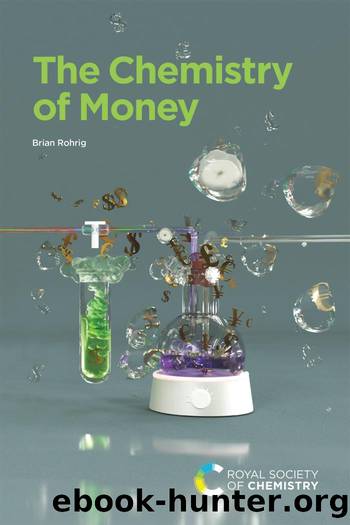The Chemistry of Money by Brian Rohrig

Author:Brian Rohrig [Rohrig, Brian]
Language: eng
Format: epub
ISBN: 9781788017114
Publisher: RSC Publishing
Published: 2020-10-07T00:00:00+00:00
4.8 REMOVING SILVER TARNISH
Meticulous housekeepers often go to great lengths to remove silver tarnish. Commercial silver cleaners contain abrasive compounds such as chromium oxide, aluminum silicate or calcium carbonate that will remove this layer of corrosion. The problem with using abrasive compounds to remove tarnish is that silver is removed also, as tarnish is generally composed of silver sulfide. If you polish your silver enough, you will eventually end up with no silver at all!
There are several ways to remove unsightly silver sulfide from a coin without causing too much harm. The key is to find a substance that breaks down the silver sulfide coatingâeither through dissolving or chemically reactingâwithout damaging the underlying silver. Silver sulfide is known for its insolubilityâits Ksp (solubility product constant) is an impressive 6.3Ã10â50. Ksp values provide a way to quantify the solubility of a substance in waterâthe smaller the Ksp value the less soluble it is. By contrast, sodium chloride, which is quite soluble in water, has a Ksp value of 37.
Silver sulfide is insoluble in most acids and bases, too. It will dissolve in nitric acid though, but that's the last thing you want to use, as nitric acid reacts vigorously with silver, as well as copper. Silver sulfide will, however, react with alkali cyanide solutions, but cyanide compounds won't react with elemental silver, which is good. It is extremely important not to expose any cyanide compound to an acid, as doing so will liberate extremely toxic hydrogen cyanide gas.
A world-renowned numismatist died while cleaning silver coins with a cyanide solution, but not from the production of toxic fumes. In 1922, J. Sanford Saltus, president of both the New York Numismatist Club and the British Numismatic Society, was found dead in his London hotel room. He had prepared some cyanide solution in a glass, and was using it to clean some silver coins in his room. He had ordered some ginger ale, which he poured into a glass as well. Tragically, he drank from the wrong glass, dying shortly thereafter. Although the death was ruled an accident, others suspected suicide, as he was having some personal troublesâhis fiancé had recently called off their engagement. Nevertheless, the official cause of Saltus's demise was listed by the coroner as âdeath by misadventureâ.6
Despite their toxicity, solutions made from sodium or potassium cyanide are highly effective at removing silver tarnish. A quick dip in a cyanide solution will remove silver tarnish almost immediately, as described by the following reaction:
Ag2S(s)+4KCN(aq) â K2S(aq)+2KAg(CN)2(aq)
Both products, potassium sulfide and potassium silver cyanide, are water soluble, so rinsing the coin with water will remove these byproducts. Despite its effectiveness, cyanide solutions have somewhat fallen out of favor amongst coin collectors owing to their tendency to react with the silver, albeit slightly, producing a dull, cleaned appearance, stripping away some of the coin's luster.
Another method that produces good results is the acidified thiourea (NH2CSNH2) dip. Acidified thiourea is the active ingredient in Tarn-X Tarnish Remover. Thiourea is a chelating, or sequestering agent. Chelating agents have the ability to remove metals, and are often used to treat heavy metal poisoning.
Download
This site does not store any files on its server. We only index and link to content provided by other sites. Please contact the content providers to delete copyright contents if any and email us, we'll remove relevant links or contents immediately.
How to Be a Bawse: A Guide to Conquering Life by Lilly Singh(7393)
Spare by Prince Harry The Duke of Sussex(5072)
Millionaire: The Philanderer, Gambler, and Duelist Who Invented Modern Finance by Janet Gleeson(4376)
Machine Learning at Scale with H2O by Gregory Keys | David Whiting(4183)
Never by Ken Follett(3791)
Harry Potter 02 & The Chamber Of Secrets (Illustrated) by J.K. Rowling(3622)
The Heroin Diaries by Nikki Sixx(3496)
Urban Outlaw by Magnus Walker(3342)
Harry Potter and the Prisoner of Azkaban (Book 3) by J. K. Rowling(3304)
Fairy Tale by Stephen King(3220)
Japanese Design by Patricia J. Graham(3110)
The Man Who Died Twice by Richard Osman(2997)
The Club by A.L. Brooks(2862)
Stacked Decks by The Rotenberg Collection(2812)
Will by Will Smith(2793)
Harry Potter and the Deathly Hallows (7) by J.K. Rowling(2643)
Churchill by Paul Johnson(2506)
The Chimp Paradox by Peters Dr Steve(2298)
Borders by unknow(2229)
